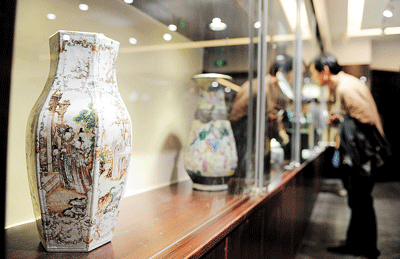 DURING his first visit to Shanxi, a 1,000-year-old town in Jiangxi Province known for making porcelain, Eric Kaplan from the United Kingdom received a blue and white plate bearing his family’s insignia. He received the gift at the ongoing 2015 China Jingdezhen International Ceramic Fair. Bearing the serial number 001, it was one of five newly fired porcelain plates in imitation of pieces originally manufactured by Jingdezhen crafters some 600 years ago for European aristocrats. Having grown up with a lot of fine china in his home, the descendant of a noble family in Leicestershire said it felt amazing to obtain something similar to those collected by his ancestors. “We appreciate this art very much, and I am extremely honored to be here and very thankful,” said Kaplan. Master pottery maker Huang Yunpeng, who presented the plate to Kaplan as a gift, has collected more than 300 antique ceramics tailor-made by local crafters for clients in Europe, including aristocrats, high-ranking officials, wealthy merchants and social organizations. His son, Huang Bin, president of the Jingdezhen Imperial Kiln Company, said he hopes these antique porcelain pieces will encourage people to remember Jingdezhen’s ties to British nobles and boost the town’s handmade porcelain industry. A royal heritage Hu Yinjiao, a resident of Jingdezhen, takes pride in the town’s history as an imperial porcelain supplier, not just for Chinese emperors but also European royals and nobles. In the late Ming Dynasty (1368-1644), Jingdezhen was not only the home of imperial kilns dedicated to Chinese emperors but was also known as a porcelain exporter. It is estimated that some 100 million pieces of china were sold to Europe from the 16th to 18th centuries. “In overseas museums, quite a number of exquisite porcelain antiques for European royals and aristocrats were made in Jingdezhen. To understand how famous the city was, just look at the mark below each antique. Oftentimes, only the city is mentioned — adding the country was seemingly unnecessary,” said Hu. “When browsing armorial porcelain antiques in overseas museums, I can feel the town’s strong connection with the royalty there,” said Hu. In Exhibition Hall A at the ceramics fair in Jingdezhen, Chinese swarm the stands of royal suppliers to appreciate the designs. Moorcroft, a 118-year-old brand based in Stoke-on-Trent of Staffordshire in England and an appointed “potter to H.M. The Queen” until 1978, is one of the most popular ceramics makers at the expo. Head of sales Gina McNicholas said that Moorcroft’s heritage as a supplier to the Queen and the royal family helps its sales in China. “We’ve found our traditional English products have sold better than anything in China. It’s very regal and royal. I think people buy into that idea,” said McNicholas. Moorcroft has hired a Hong Kong agent to deal with exports to China. The brand has a history of working with overseas markets to establish new designs so designers can influence one another and come up with new ideas about how things will sell in each market. McNicholas told Xinhua that the company would also cooperate with ceramics makers in Jingdezhen. “It’s about working together to share ideas and best practices and boost the U.K. and Chinese brands as well,” she said. Modern challenge However, master porcelain artist Duan Zhenmin said restoring the city’s past glory in the ceramics market faces a major challenge because it lacks famous international brands. “You can’t find a Chinese name on the list of the world’s top luxury ceramic brands. Jingdezhen is only a place of origin shared by local pottery makers,” said Duan, who founded Jiuduanshao Ceramics Factory. By contrast, a number of heavyweight manufacturers have emerged over the past two centuries as suppliers for European royals, aristocrats and luxury consumers, including Royal Copenhagen, France’s GIEN, Hungary’s Herend, Britain’s Royal Doulton and Wedgewood and Germany’s Meissen. “The absence of an international brand in Jingdezhen also brings an opportunity, and we are aiming to renew the heritage of royal quality,” said Huang Bin from Imperial Kiln. To protect its production techniques and guarantee quality, Imperial Kiln Company has given a special ID to each of its products. The local government is also building a database in an attempt to track luxury porcelain for export. Bian Xiaodong, a pottery maker in Jingdezhen, is confident about the city’s ability to gain a foothold in the world’s high-end ceramics market if the local industry can act quickly to build brands. “Most domestic masters have dedicated themselves to the design of single works, failing to promote their products under a brand name. But we still have the best production techniques,” he said. He said one example was the tableware designed by master Huang Chunmao from the China Central Academy of Fine Arts for an evening banquet at the 2014 APEC summit in Beijing, which was attended by national leaders and high-ranking guests from 20 countries. Inspired by teacups from the Song Dynasty (960-1276), the tableware, which combined modern techniques and traditional enamelware, was impressive and received industry recognition, according to Bian. To inspire innovation and cooperation, an industrial park featuring artists’ studios and workshops recently opened in Jingdezhen, where masters of handmade porcelain and those who use special techniques can produce and exhibit their wares. Wu Jiangzhong, a local ceramics master who specializes in large chinaware, has moved his kiln to Mingfang Park and expects it to help boost the industry in the global market. “Each studio has its unique technique passed down from the old generations and special customers. If we work together, we can inspire and foster our porcelain culture and create a brighter future,” said Wu. (Xinhua) | 
